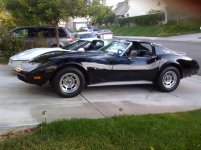AV8R
Well-known member
Hello,
I have a 1990 C4 L98 automatic transmission California Corvette that has failed only on the NOx numbers (all other tests passed):
NO (ppm)
15mph: 1325 (541 max)
25mph: 1207 (498 max)
2 years ago the Cats were replaced by a local shop, as well as the EGR valve, and the exhaust headers were cleaned out. Then it passed the non gold shield SMOG tests.
Now I have to pass the gold shield SMOG and its failing. Ive read that a EGR valve is often the culprit for very high NOx numbers. Also, Im told that cats going bad wont show up as just high NOx values.
So my questions are thus:
a. Do you agree that a new EGR valve is the way to go?
b. Positive or negative pressure (I believe Ive read negative for high NOx values)?
c. What GM Delco part number(s) would I search for? (ACDelco 214-5535)
d. And if its not the EGR, what else could it be? (O2 sensor, mixture?)
I recently replaced the fuel injectors because the originals shorted out - as they do eventually Im told.
Now on a related topic, the shop that replaced the precats and cats may have put in the wrong cats (as the gold shield US Smog shop told me when the vette failed recently)
They state that the cats put on my car were not those called out by the State Air Resources Board, Executive Order D-193-87. Rather what is on the car are D-280-80, which are for a truck. Does any of this make sense and ring true? (remember, I did pass the non-gold shield SMOG test with these earlier).
Before I take my vette to another and more trusted shop, can I get some insights?
Thank you.
I have a 1990 C4 L98 automatic transmission California Corvette that has failed only on the NOx numbers (all other tests passed):
NO (ppm)
15mph: 1325 (541 max)
25mph: 1207 (498 max)
2 years ago the Cats were replaced by a local shop, as well as the EGR valve, and the exhaust headers were cleaned out. Then it passed the non gold shield SMOG tests.
Now I have to pass the gold shield SMOG and its failing. Ive read that a EGR valve is often the culprit for very high NOx numbers. Also, Im told that cats going bad wont show up as just high NOx values.
So my questions are thus:
a. Do you agree that a new EGR valve is the way to go?
b. Positive or negative pressure (I believe Ive read negative for high NOx values)?
c. What GM Delco part number(s) would I search for? (ACDelco 214-5535)
d. And if its not the EGR, what else could it be? (O2 sensor, mixture?)
I recently replaced the fuel injectors because the originals shorted out - as they do eventually Im told.
Now on a related topic, the shop that replaced the precats and cats may have put in the wrong cats (as the gold shield US Smog shop told me when the vette failed recently)
They state that the cats put on my car were not those called out by the State Air Resources Board, Executive Order D-193-87. Rather what is on the car are D-280-80, which are for a truck. Does any of this make sense and ring true? (remember, I did pass the non-gold shield SMOG test with these earlier).
Before I take my vette to another and more trusted shop, can I get some insights?
Thank you.







